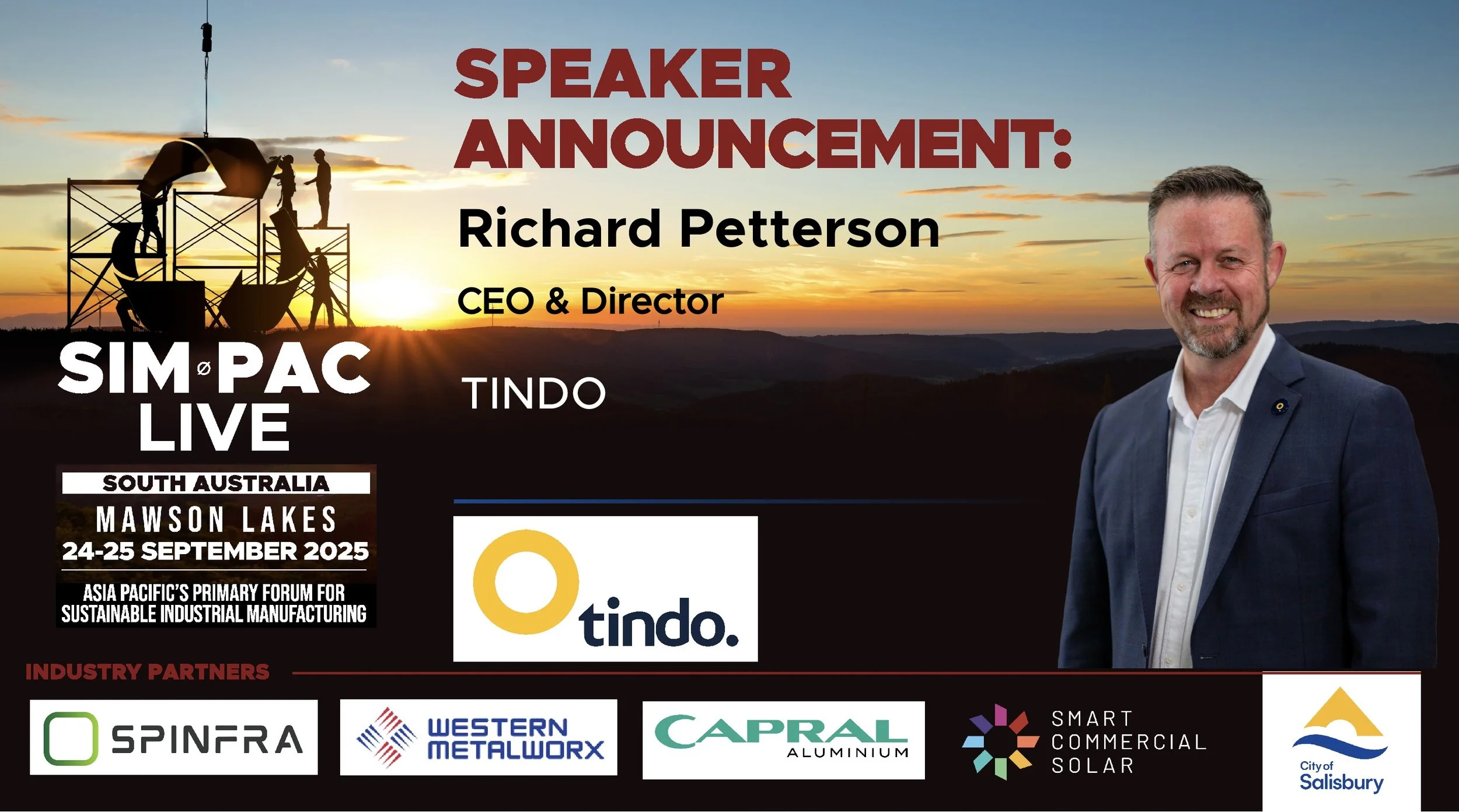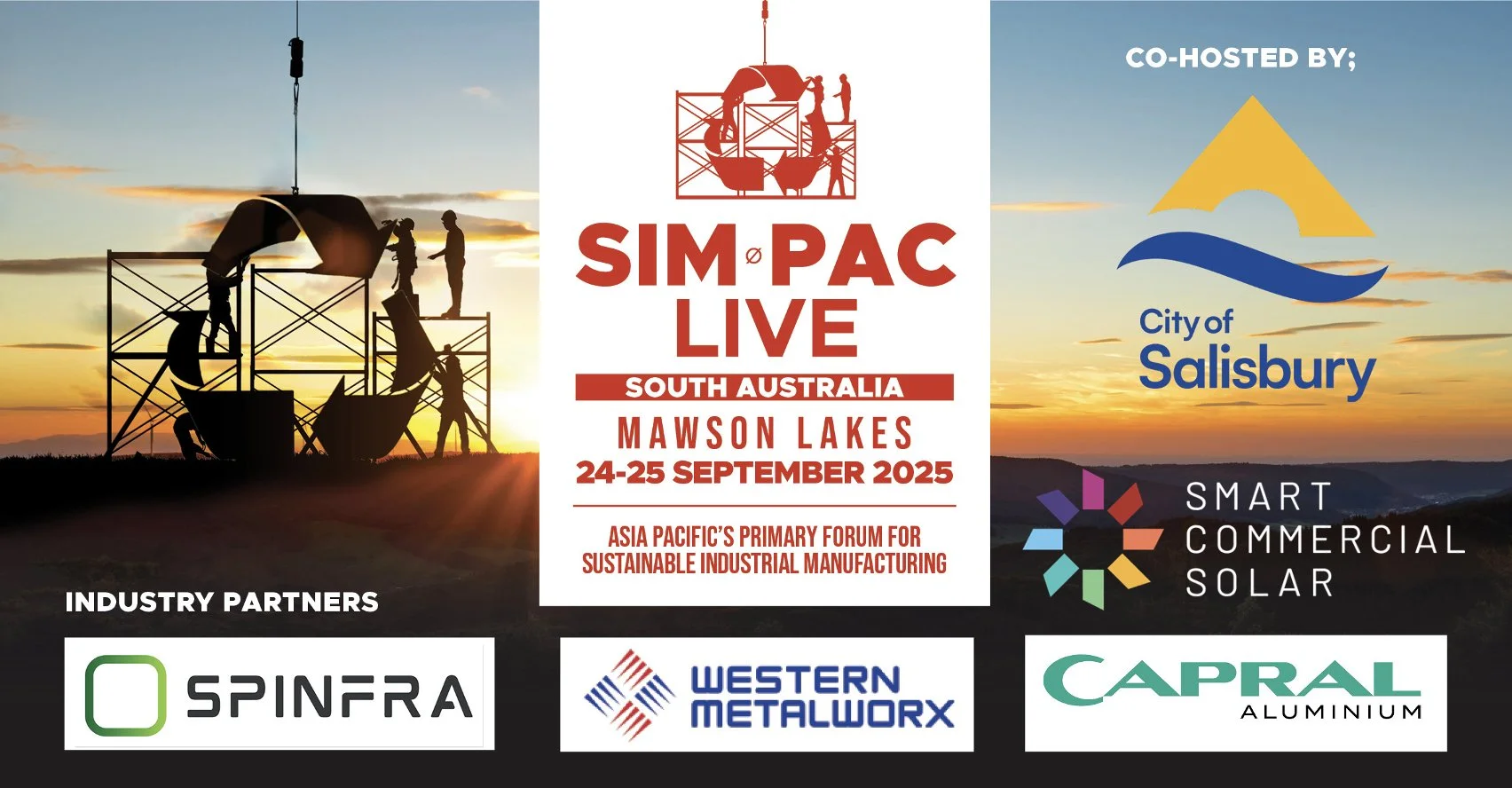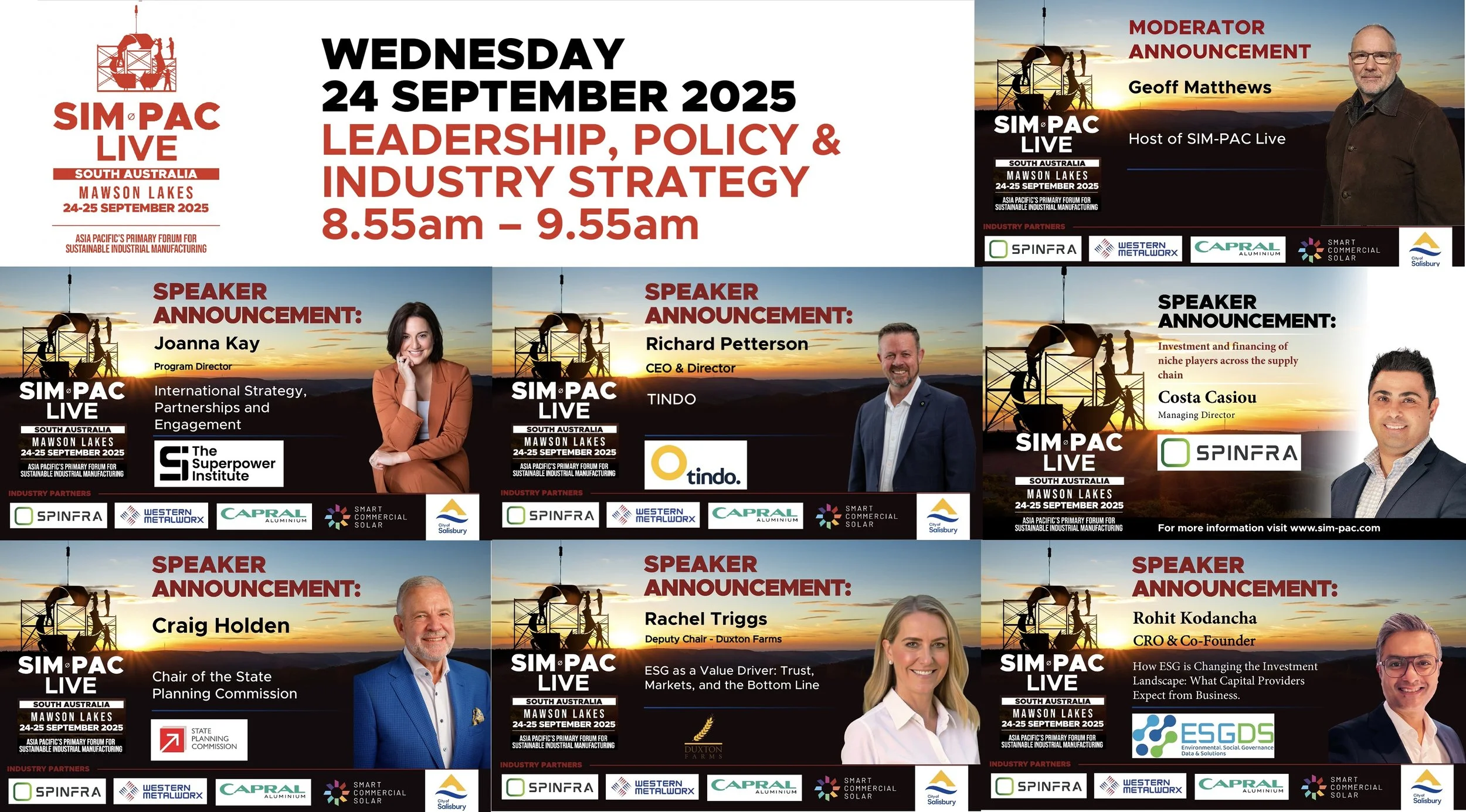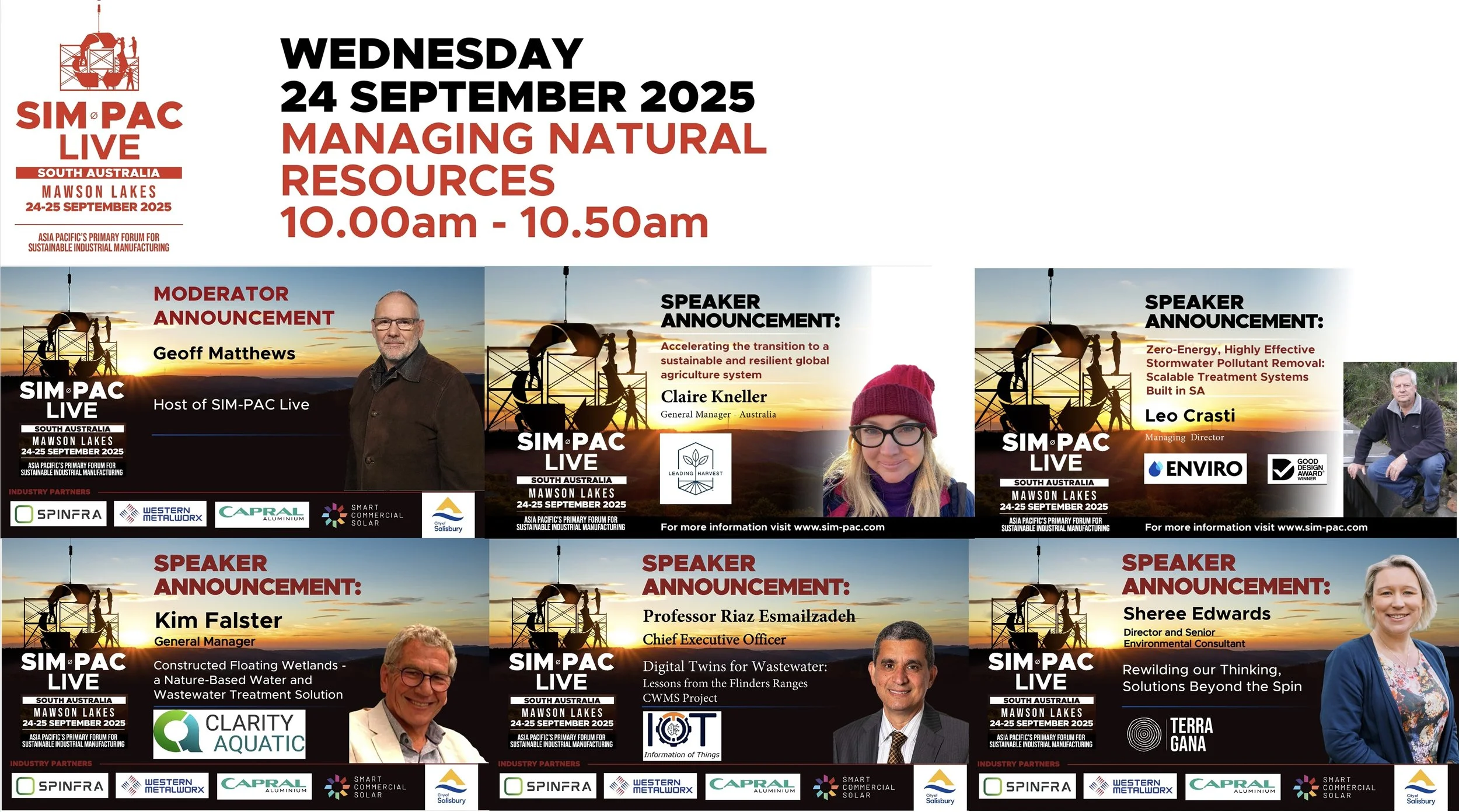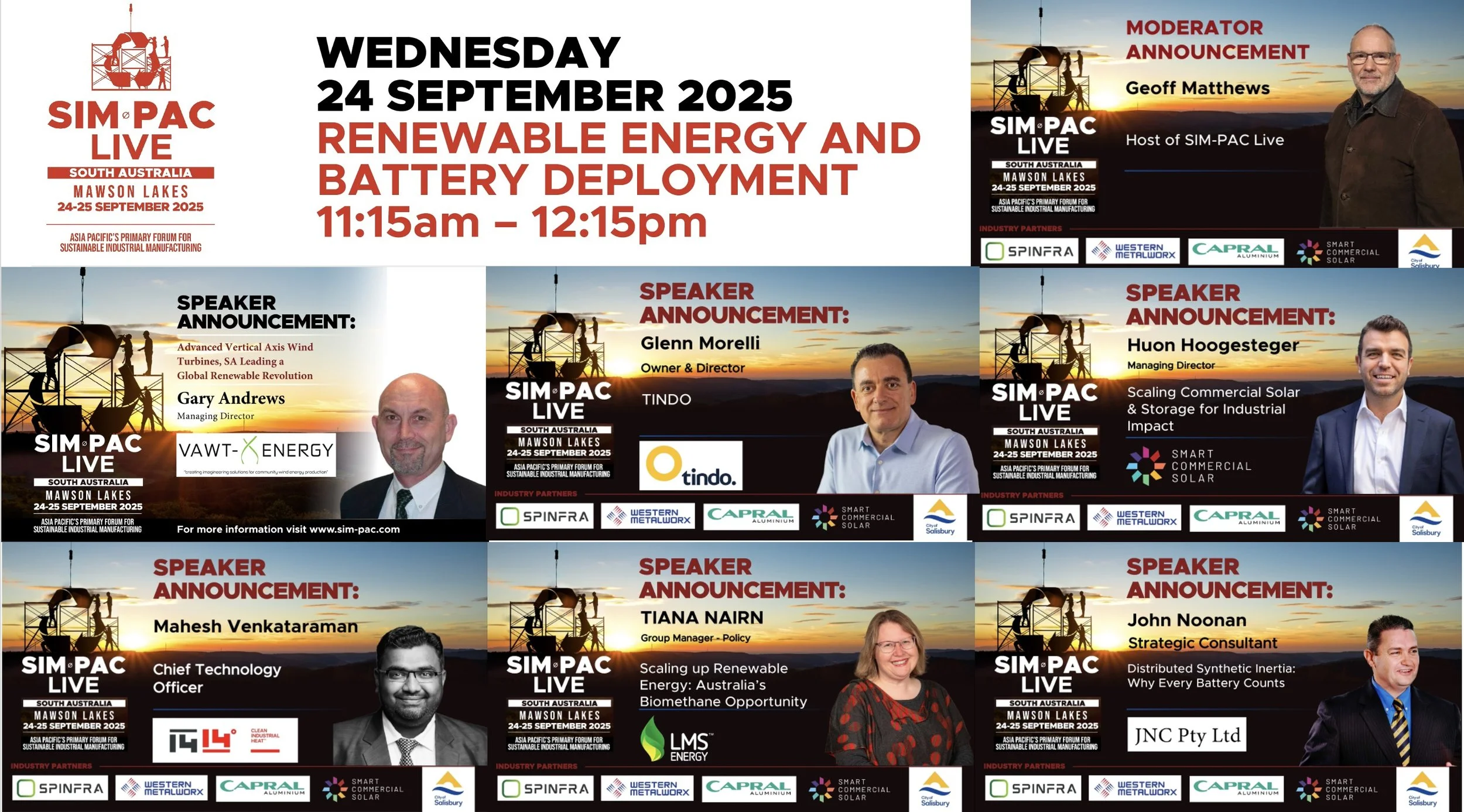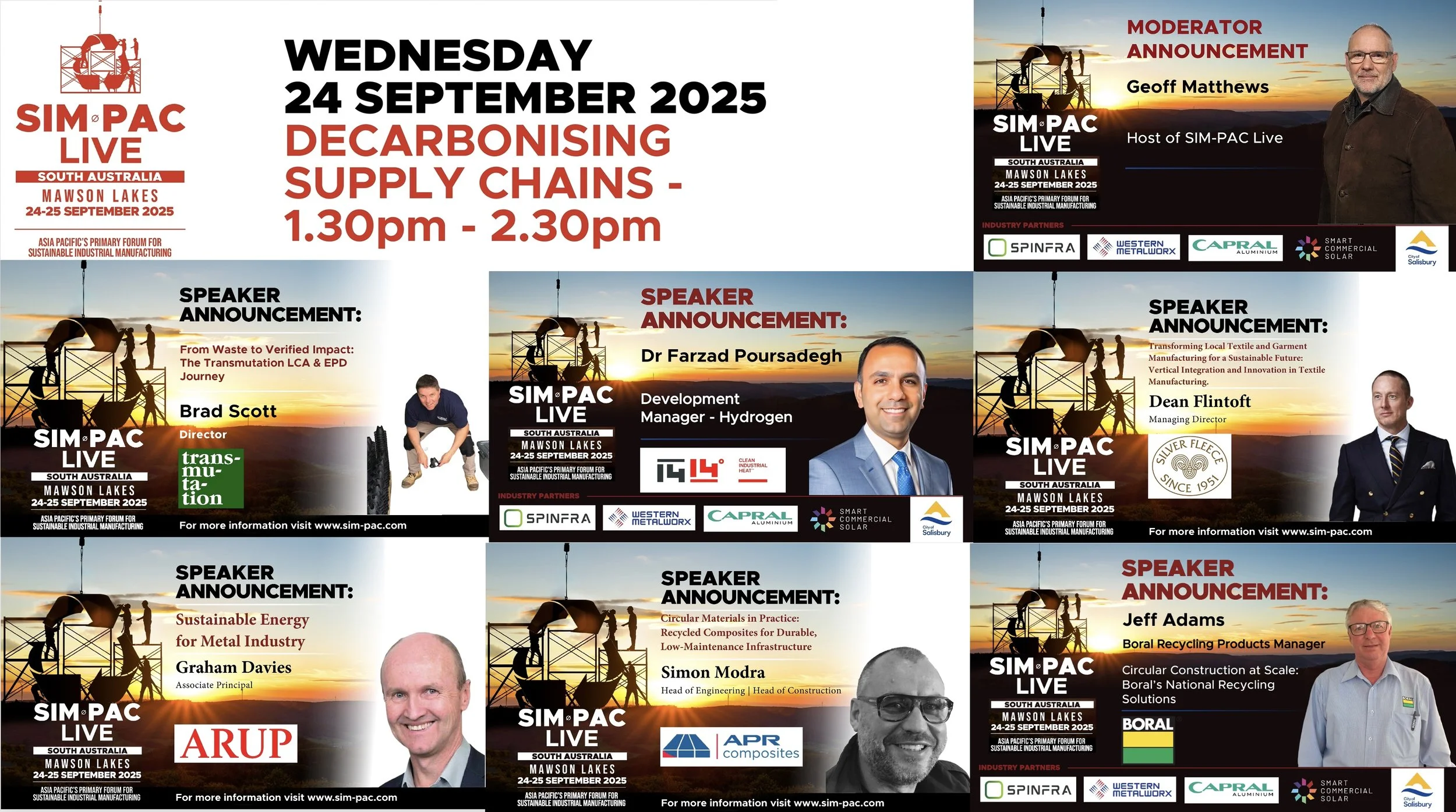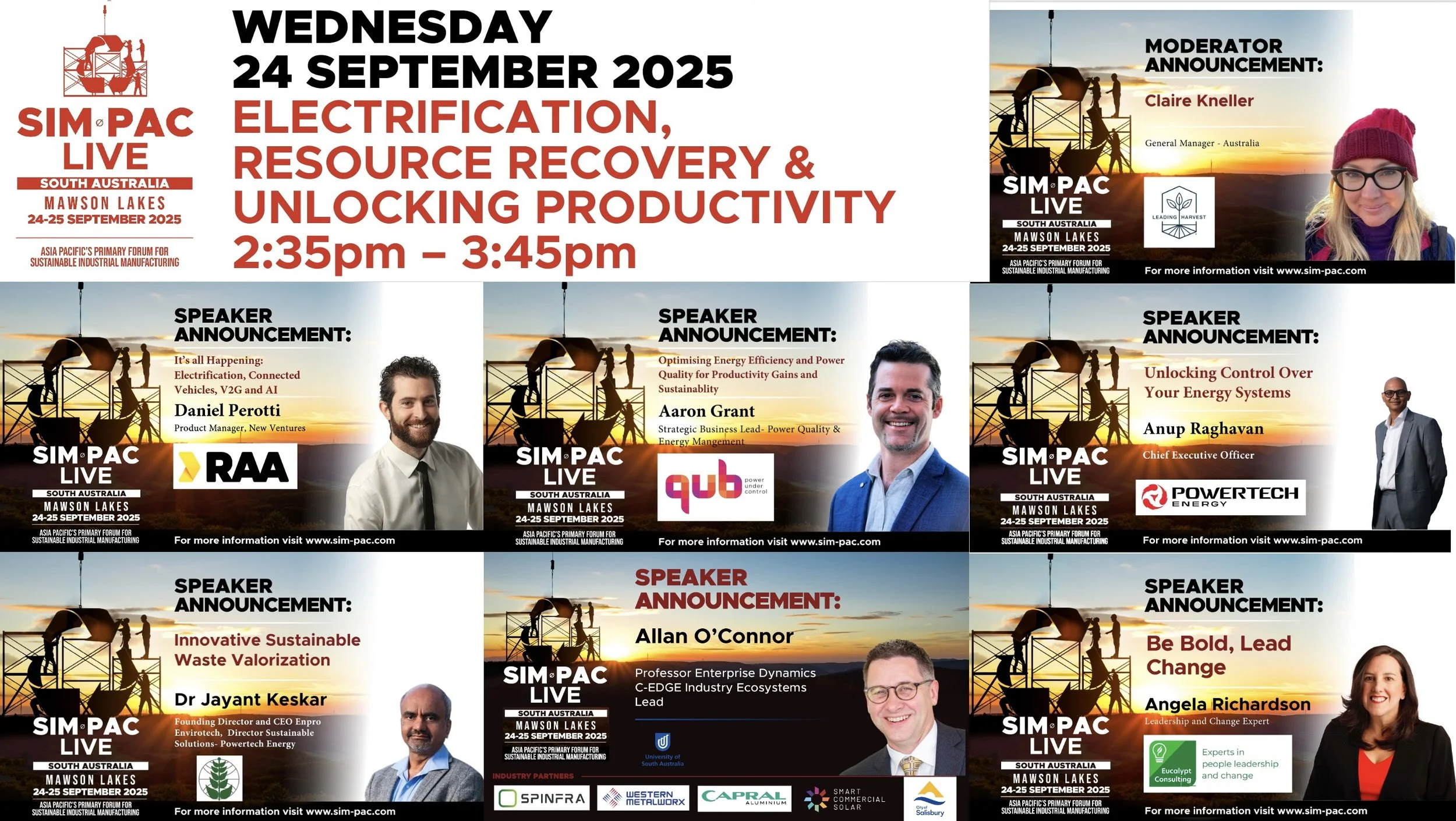SIM-PAC Live South Australia
Crowne Plaza Adelaide Mawson Lakes
24 September 2025
SIM-PAC Live South Australia 2025 brought together leaders from government, industry, finance, and community to showcase the state’s role at the forefront of sustainability and clean industry. With over 50 registrations and strong South Australian representation, the event featured five dynamic sessions covering leadership and policy, natural resource management, renewable energy innovation, supply chain decarbonisation, and electrification. Across the day, speakers highlighted world-firsts in rooftop solar, battery adoption, grid-forming inverters, advanced manufacturing, waste-to-value solutions, and ESG-driven business models. The program demonstrated how South Australia is not only meeting the challenges of the energy transition but setting benchmarks for the world, with collaboration and innovation driving a cleaner, more competitive future.
Day 1 – Conference (Wednesday, 24 September 2025)
7:55am – 8:55am
SPINFRA Espresso Hour, Networking & Welcome
Hosts: Geoff Matthews — SIM-PAC Live Event Director & Host, Costa Casiou, SPINFRA
8:55am – 9:55am — Leadership, Policy & Industry Strategy
Moderator: Geoff Matthews
The opening session sets the tone for SIM-PAC Live South Australia. Leaders from government, finance, academia, and industry will share strategic insights on growth, innovation, and investment pathways. This is where policy meets practice — and where bold ideas for South Australia’s industrial future are put on the table.
Joanna Kay — Super Power Institute — Leadership/Innovation (TBC)
Richard Petterson - CEO and Director - Tindo
Costa Casiou — SPINFRA — Investment & financing across supply chains
Craig Holden — Chair, State Planning Commission — Balancing Growth, Affordability, and Sustainability
Rachel Triggs — ESG as a Value Driver: Trust, Markets, and the Bottom Line
Rohit Kodancha — ESG Data & Solutions — How ESG is Changing the Investment Landscape: What Capital Providers expect from Business
Angela Richardson — Eucalypt Consulting — Be Bold, Lead Change
Joanna Kay – The Superpower Institute
Joanna Kay delivered an ambitious vision for South Australia’s role in the global energy transition. Speaking on behalf of the Superpower Institute, she framed the challenge not just as producing clean energy, but embedding it into green industrial products—steel, aluminium, hydrogen, fertilisers, and advanced manufacturing. Kay outlined three big ideas: (1) play to South Australia’s comparative advantages in renewables and industry,
(2) align policy with investment pathways to capture a share of the projected $700 billion global green export opportunity by 2050, and
(3) position South Australia globally by supporting trading partners’ decarbonisation. She painted a vivid picture of Whyalla as a green steel hub, Port Pirie as a clean metals centre, Eyre Peninsula as a renewable powerhouse, and Adelaide as a global climate capital. Her closing call emphasised leadership bold enough to turn risk into opportunity, pragmatic enough to build policy, and collaborative enough to align government, finance, academia, and industry.
Richard Petterson – Tindo Solar
Richard Petterson shared the story of Tindo Solar, Australia’s only local solar panel manufacturer. He positioned Tindo as a proudly homegrown success story—committed to ethical supply chains, anti-slavery principles, and strong sustainability credentials. Petterson spoke about their zero-defect manufacturing processes, market-leading warranties, and recognition as a CHOICE®-recommended product. His address underscored the potential of Australian advanced manufacturing and the role it can play in South Australia’s clean energy leadership.
Costa Casiou – SPINFRA
Costa explored the capital constraints facing mid – sized infrastructure and renewable projects, particularly those in the $5–20 million range. He outlined how these projects often fall into a funding “blind spot”—too small for institutional investors, but too large for angel or grassroots capital. Costa explained how SPINFRA bridges this gap, connecting niche project developers with appropriate funding sources. His presentation highlighted the importance of innovative financing models to accelerate the delivery of sustainable infrastructure in South Australia.
Craig Holden – Chair, State Planning Commission
Craig Holden provided an overview of the 30-Year Plan for Greater Adelaide, which anticipates up to 670,000 additional residents over three decades, 315,000 new homes, and 254,000 new jobs. His presentation underscored the challenge of balancing growth with liveability—ensuring that people not only have housing but also access to transport, infrastructure, and jobs. He highlighted the need for strategic planning to support population growth while protecting South Australia’s natural assets and agricultural land. The Chair’s message was one of preparedness: building today for the communities of tomorrow.
Rachel Triggs – Duxton Farms
Rachel Triggs discussed the global evolution of ESG standards and their implications for Australian agribusiness, particularly the wine industry. She drew attention to complex international labelling and compliance requirements, especially those emerging from the EU, and noted how these shape export markets. Triggs also spoke about Duxton Farms’ expansion, sharing how the business is preparing to meet sustainability-driven regulatory expectations. The takeaway was that alignment with international ESG requirements is increasingly critical for long-term competitiveness.
Rohit Kodancha – ESG Data & Solutions
Rohit Kodancha explained how ESG considerations are transforming investment decisions. He emphasized that investors and capital providers increasingly demand credible, decision-grade ESG data and evidence of transition plans. Without this, businesses face rising costs of capital or exclusion from investment. Kodancha argued that ESG has shifted from a “soft” reputational factor to a hard financial determinant, influencing which projects and companies secure funding. His talk underscored the rising importance of robust measurement, reporting, and assurance in ESG.
Angela Richardson
Angela Richardson focused on the role of leadership in cultural transformation, particularly when organizations commit to sustainability goals. She emphasized the importance of leaders modelling “good behaviours”—transparency, accountability, and inclusiveness—that encourage wider organizational adoption of change. Richardson’s talk provided practical insights into how sustainable transformation must be led from the top, not just through strategy but through visible, consistent behaviours.
10:00am – 10:50am — Panel: Managing Natural Resources
How do we manage our natural resources sustainably while building resilient industries? This panel brings together leading researchers, innovators, and practitioners to showcase nature-based solutions, digital innovation, and scalable technologies that are reshaping the way we think about water, waste, and ecosystems.
Moderator: Geoff Matthews
Claire Kneller - General Manager - Leading Harvest - Accelerating the Transition to a Sustainable and Resilient Global Agriculture System
Leo Crasti — Enviro Australis — Zero-Energy, Highly Effective Stormwater Pollutant Removal: Scalable Treatment Systems Built in SA
Kim Falster — Clarity Aquatic — The Use of Constructed Floating Wetlands as a Nature-Based Water and Wastewater Treatment Solution
Professor Riaz Esmailzadeh — IoT Consultants — Digital Twins for Wastewater: Lessons from the Flinders Ranges CWMS Project
Sheree Edwards, Director and Senior Environmental Consultant, Terra Gana - Rewilding our thinking, solutions beyond the spin
Claire Kneller – Leading Harvest
Claire Kneller introduced Leading Harvest, a global nonprofit advancing sustainability outcomes in agriculture through its universal Farmland Management Standard. Her talk emphasized the importance of independent certification and outcomes-based frameworks for farming enterprises, especially as investors and markets demand greater accountability in natural resource management. Kneller outlined how transparent, verifiable standards not only improve environmental performance but also help producers build trust with consumers, regulators, and financiers. A key takeaway: aligning production with sustainability metrics is now a market expectation, not just an aspiration.
Leo Crasti (Enviro – Stormwater Management Solutions)
Leo outlined an all-in – one, in-line stormwater treatment system (Enviro EPS) that replaces multi-step “treatment trains” with a single device using hydraulic separation to remove sediments, trash, litter and oils. Framed by practical harvesting examples (e.g., ~7.5M L/yr from 30 households at 500 mm rainfall; ~450 L/day captured along a typical 3-lane highway), his talk emphasised performance with lower install/maintenance cost and a 100-year service life. Crasti highlighted South Australian design and manufacture, recyclable materials (green concrete chambers, stainless inserts), and inclusive employment via NDIS work hours.
He also detailed the OE Series for fuel – dispensing sites, adding a larger chamber, 2-metre water trap and bulk spill containment (>10,000 L) to protect waterways. Compliance and durability were central: EN858-1 and Australian code alignment, oil/water separation certification by the Australian Flow Management Group, Re-Poly fibre reinforcement from recycled feedstocks, and simple annual maintenance with a sucker truck—avoiding confined-space entry and business shutdowns. Overall, the pitch was a nature-positive, circular approach to urban water with robust engineering and easy operations.
Kim Falster – Clarity Aquatic
Kim Falster presented on the use of Constructed Floating Wetlands (CFWs) as a nature-based water and wastewater treatment solution. These systems harness plant root systems to slow water flow, enhance sedimentation, and support microbial biofilms that strip nutrients from water bodies. Falster highlighted the wide range of applications — from polishing wastewater in treatment lagoons to improving irrigation water quality on farms, reducing nutrient loads in stormwater, and preventing algal blooms in rivers and lakes. He also stressed co-benefits like carbon sequestration and providing habitats for aquatic life. The session demonstrated how CFWs support a circular economy approach and offer scalable, cost-effective solutions across agriculture, mining, and municipal infrastructure.
Riaz Esmailzadeh – IoT Consultants
Riaz Esmailzadeh spoke on the role of Digital Twins in wastewater management, focusing on the Quorn Community Wastewater Management System. He explained the four levels of digital twin maturity: static, connected, predictive, and autonomous. The project aims to reach at least a Level 3 predictive twin, enabling proactive maintenance alerts and scenario simulation. Esmailzadeh highlighted how digital twins can become a single source of truth, integrating real-time sensor data, asset management, and process logic into one dynamic platform. His key message was that digital twins transform asset management from reactive to intelligent, delivering efficiency gains and better resource use.
Sheree Edwards – Terra Gana / Cooltong Station
Sheree Edwards shared insights from Cooltong Station, a Renewable Resources Group project blending sustainable agriculture, renewable energy, and conservation outcomes. Her presentation detailed how Terra Gana supported large-scale habitat restoration for the threatened mallee bird species community in the Riverland, alongside nearly 1 million almond trees. The project secured a South Australian Heritage Agreement over 5,400 hectares and integrates investment benefits with ecological outcomes. Edwards’ talk highlighted the growing investor appetite for projects that combine tangible production with measurable biodiversity and conservation achievements.
10.50am - 11.10am - Morning tea
11:15am – 12:15pm — Renewable Energy + Battery Deployment
Moderator: Geoff Matthews
South Australia is at the forefront of the global energy transition. This session explores emerging technologies, renewable fuels, storage systems, and innovative business models that are powering industry forward. From thermal storage to biomethane and solar scaling, speakers will highlight the breakthroughs shaping tomorrow’s energy landscape.
Gary Andrews — VAWY-X Energy - Advanced Vertical Axis Wind Turbines
Glenn Morelli - Owner & Director, TINDO
Huon Hoogesteeger — Smart Commercial Solar — Scaling Commercial Solar and storage for Industrial Impact
Mahesh Venkataraman — 1414 Degrees — SiBox Thermal Storage
Tiana Nairn — LMS Energy — Scaling up renewable energy: Australia’s biomethane opportunity
John Noonan — Strategic Consultant — Distributed Synthetic Inertia: Why Every Battery Counts
Gary Andrews – VAWT-X Energy
Gary Andrews presented VAWT – X Energy’s vertical axis wind turbine (VAWT) technology. Unlike conventional horizontal axis turbines, the VAWT-X design is compact, quiet, and suited for distributed, off-grid, or community-scale energy generation. The company has developed both 6 kW and 80 kW models, with potential applications across farms, remote communities, ports, EV charging, and industrial sites. Andrews argued that decentralising wind generation into microgrids can reduce diesel reliance, improve energy resilience, and lower emissions in hard-to-reach areas. His talk demonstrated how small- to medium-scale wind can complement solar and batteries in hybrid systems.
Glenn Morelli, Owner & Director of Tindo
Glenn Morelli, Owner & Director of Tindo presented on the fast-changing landscape of Australia’s solar and battery markets, shaped in large part by the federal Cheaper Home Batteries program. He highlighted that while battery sales are booming — with a rolling 12-month quarterly average of over 32,000 and more than 60,000 installed since July — rooftop solar installations have dropped 18% year-on-year. Morelli cautioned that such government-driven artificial markets risk creating instability, attracting low-quality operators and products, and exposing consumers to poor system design and business failures.
To address these challenges, Tindo has developed a three-step program that shifts the conversation from cost to long-term value. This involves educating customers on actual usage and bill impacts, expanding the solution to include the right-sized solar-plus-battery package, and empowering customers by focusing on outcomes rather than price. According to Morelli, partners applying this approach are achieving 50% sales growth, while delivering more reliable systems and greater customer satisfaction. The presentation reinforced Tindo’s commitment to trusted, Australian-made solutions that prioritise durability, performance, and sustainability.
Huon Hoogesteger – Smart Commercial Solar
Huon Hoogesteger delivered one of the most striking presentations of the session, updating a slide first used at SIM-PAC Live Queensland in February 2025. The before-and-after numbers, just nine months apart, showed extraordinary growth in solar and storage adoption, underscoring how fast the commercial energy landscape is shifting. His central message was that energy should no longer be seen merely as an overhead cost, but as a strategic asset for resilience, competitiveness, and growth. Through integrated solar and battery solutions, Smart Commercial Solar is helping industrial clients reduce costs, manage demand, and generate new revenue streams. The data Huon presented provided a spectacular illustration of how quickly the energy transition is accelerating in practice.
Mahesh Venkataraman – 1414 Degrees
Mahesh Venkataraman, CTO of 1414 Degrees, tackled one of the toughest challenges in industrial decarbonisation: high-temperature heat. Unlike low-temperature processes that can be electrified, industries requiring heat above 300–400°C — such as metals, glass, and ceramics — have long been considered “hard-to-abate.” Venkataraman showcased 1414 Degrees’ breakthrough thermal energy storage system, which captures renewable energy (including solar) and stores it for later use at temperatures between 600°C and 1,000°C. This technology has the potential to replace fossil fuels in heavy industry, marking a major leap forward in industrial decarbonisation. His talk drew attention to how South Australian innovation is tackling global-scale problems.
Tiana Nairn – LMS Energy
Tiana Nairn outlined the opportunity for biomethane as a renewable substitute for natural gas. She explained how biomethane can be produced at scale from waste and agricultural inputs, dropped directly into existing gas infrastructure, and used as an industrial feedstock. With recoverable potential equivalent to 96% of current east coast gas consumption, biomethane represents a viable pathway to decarbonise sectors that rely on gas for both energy and industrial processes. Nairn argued that biomethane also delivers energy security, regional jobs, and circular economy benefits. Her key message: renewable gases are an essential complement to solar, wind, and batteries in the clean energy mix.
John Noonan – Every Battery Counts
John Noonan’s presentation underscored South Australia’s role as a global laboratory for grid transformation. He noted that SA now has 350,000 rooftop solar systems (~1.8 GW) and 60,000 residential batteries (~600 MW), alongside utility-scale projects, making it one of the most advanced distributed energy systems in the world. Crucially, he argued that SA is proving it’s possible to transition from traditional synchronous generation to a fully inverter-based grid powered by solar and batteries — something few believed possible a decade ago. His talk highlighted the lessons learned from managing such a system, with SA setting a global benchmark for renewable integration.
12:15 – 12:30 — Special Guest Speaker, Mayor Gillian Aldridge OAM — City of Salisbury
12:30 – 1:30 — Lunch
1:30 – 2:30 — Decarbonising Supply Chains
What will it take to decarbonise supply chains and transport in practice? This session features real-world examples of industrial transformation, from product lifecycles and emissions measurement to electric vehicle integration and materials innovation. Attendees will gain insights into both the challenges and opportunities of building low-emissions value chains.
Moderator: Geoff Matthews
Brad Scott — Transmutation — From Waste to Verified Impact: The Transmutation LCA & EPD Journey
Farzad Poursadegh — 1414 Degrees — Hydrogen Development for Industrial Supply Chains
Dean Flintoft — Silver Fleece — Transforming Local Textile and Garment Manufacturing for a Sustainable Future
Graham Davies — Arup — Sustainable Energy for the Metal Industry
Simon Modra — APR Composites — Circular Materials in Practice: Recycled Composites for Durable, Low-Maintenance Infrastructure Landscape: What Capital Providers Expect from Business
Jeff Adams — Boral Recycling Products Manager — Circular Construction at Scale: Boral’s National Recycling Solutions
Brad Scott – Transmutation
Brad Scott introduced Transmutation’s journey with Life Cycle Assessments (LCA) and Environmental Product Declarations (EPDs), which provide verified environmental performance data for products. He explained how these tools are increasingly becoming essential in construction and manufacturing procurement, but also highlighted the challenges for small businesses given the costs and technical barriers. Using Transmutation’s PostPrime® resin as a case study, Scott outlined the five steps of the process — from scoping and data collection through to verification and publication. His takeaway message was simple but powerful: start small, treat data as an asset, and leverage EPDs to build trust and market access.
Farzad Poursadegh (1414 Degrees)
Farzad Poursadegh (1414 Degrees) presented on the role of hydrogen development for industrial supply chains, focusing on how hydrogen can act as a flexible, clean energy carrier for hard-to-abate sectors. He described hydrogen as not only a substitute fuel but also a critical enabler for industrial processes such as refining, chemicals, metals, and fertilisers — sectors where direct electrification remains limited. His talk connected hydrogen development to industrial resilience and competitiveness, arguing that South Australia is uniquely positioned with its abundant renewable resources to produce low-cost, scalable hydrogen.
Poursadegh also emphasised the integration of hydrogen into supply chains, from production through to distribution and end-use. He highlighted infrastructure challenges such as safe transport, storage, and blending with existing energy systems, referencing international safety and blending studies. His key message was that hydrogen is not just a clean fuel, but a strategic industrial input, and that building this supply chain in South Australia could underpin both local decarbonisation and global export opportunities.
Dean Flintoft (Silver Fleece)
Dean Flintoft presented their vision for the future of Australian – made textiles, blending heritage craftsmanship with cutting-edge manufacturing innovation. The company emphasised its commitment to local, sustainable, and ethical production, showing how apparel can be both high-performance and environmentally responsible. Their story highlighted how South Australian manufacturing can compete on quality, durability, and integrity — positioning locally made apparel not just as clothing, but as an expression of textile excellence with global ambition.
Graham Davies – Arup
Graham Davies, Energy and Resources Lead at Arup, spoke about sustainable energy for the metals industry — one of the most energy-intensive and emissions-heavy parts of the supply chain. He highlighted the inefficiency of current fossil-fuel-heavy processes (with energy efficiency below 25%) and argued for an integrated systems approach that connects renewable generation, electrification, storage, and demand management. He showcased promising technologies such as direct reduced iron (green iron), electric arc furnaces, and energy recovery systems as pathways to decarbonising metals production. Davies stressed that the metals sector’s transition will be pivotal for reducing South Australia’s and Australia’s overall industrial emissions.
Simon Modra – APR Manufacturing Group
Simon Modra described APR’s role as an innovation hub in recycling and sustainable product design, with its facility in Edinburgh, South Australia. He showcased how APR transforms recycled plastics and composites into infrastructure products, ranging from water tanks and lifeguard platforms to skate parks and transport projects. The company is also trialling hemp as a replacement for wood in composites, pointing to opportunities for circular design and local materials innovation. Modra’s key point was that recycling and advanced materials are not only an environmental responsibility but also a driver of industrial competitiveness.
Nathan Hall Boral Recycling
Nathan Hall shared Boral’s national-scale approach to construction and demolition waste recycling, with facilities across Australia — including South Australia. They highlighted solutions such as turning waste streams into new Boral products (e.g., glass sand) and their role in supporting Green Star and Infrastructure Sustainability Council (ISC) ratings for projects. Their presentation reinforced how circular economy practices can be scaled by large corporates, creating both sustainability benefits and commercial advantage across the supply chain.
2:35 – 3:45 — Electrification, Resource Recovery & Unlocking Productivity
Moderator: Claire Kneller
Electrification and circularity are the twin levers of industrial transformation. This session showcases technologies and strategies that cut costs, improve efficiency, and unlock new value — from advanced recycling and energy optimisation to productivity gains through digital systems and ESG. Expect dynamic perspectives on how to get more from less, while building resilience.
Daniel Perotti — RAA — Electrification, Connected Vehicles, V2G, AI
Aaron Grant — Qub — Energy Efficiency & Power Quality
Anup Raghavan — Powertech Energy — Unlocking Control Over Your Energy Systems
Dr Jayant Keskar — Enpro Envirotech / Powertech Energy — Sustainable Waste Valorisation
Nathan Hall — Boral Recycling BDM SA — Supplying Quality Recycled Materials for South Australia
Allan O’Connor — UniSA — ASPiRE 5.0 – Unlocking Productivity with Technology and ESG
Angela Richardson — Eucalypt Consulting — Be Bold, Lead Change
Daniel Perotti – RAA - V2G and AI
Daniel Perotti explored the frontier of vehicle-to – grid (V2G) and artificial intelligence as enablers of electrification. He explained how V2G allows EVs to act as distributed energy resources, feeding power back into the grid during peak times while charging at off-peak. Combined with AI-driven optimisation, V2G can provide grid stability, reduce costs, and support higher penetration of renewables. Perotti positioned these innovations as essential to creating a flexible, resilient, and intelligent energy system, and argued that Australia has the opportunity to lead in deploying them at scale.
Aaron Grant – Qub
Aaron Grant focused on power quality and energy efficiency, exploring how poor harmonics and unstable voltage directly increase costs, reduce productivity, and undermine sustainability efforts. He demonstrated that improving power quality can deliver a 10–15% reduction in energy use, with returns on investment in as little as 12–36 months. Grant also emphasized how stable, clean power underpins the transition to renewable integration — from solar to EV charging infrastructure. His takeaway: addressing power quality is a low-cost, high-impact lever for businesses pursuing both cost savings and carbon reductions.
Anup Raghavan – Power Tech Energy
Anup Raghavan presented PowerHive, a smart IoT-based platform designed to optimise energy use in tourist parks, retirement villages, and other multi-site facilities. The system links smart metering to automation, enabling features such as shutting down unused air conditioning, shifting loads to times when solar is abundant, and monitoring site-wide usage via a single dashboard. A South Australian case study at Windsor Gardens Caravan Park showed the system’s impact in lowering costs and increasing sustainability. Raghavan stressed that scalable, modular solutions like PowerHive are critical for small-to-medium operators who want to be part of the energy transition.
Dr Jayant Keskar – Enpro Envirotech
Dr Jayant Keskar highlighted Enpro Envirotech’s work in sustainable waste valorisation — turning organic and biomass waste into energy, fuels, biofertilisers, and biochar. He introduced innovations such as solid oxide electrolysis to convert waste CO₂ into syngas and liquid fuels, as well as digestate fortification that improves soil health and crop yields by up to 38%. Keskar also demonstrated the company’s decentralised solution, the FOODIE thermophilic composter, which can turn food waste into compost within 24 hours, reducing transport and landfill costs. His message: waste-to-value systems can deliver net zero outcomes, biodiversity gains, and resilience for communities and industry.
Prof Allan O’Connor – C-EDGE / ASPiRE 5.0
Professor Allan O’Connor spoke on ASPiRE 5.0, a framework for unlocking productivity by aligning technology adoption with ESG (Environmental, Social, Governance) performance. He traced the evolution of industry from mechanisation to digitalisation and into “Industry 5.0,” where human-centric, sustainable, and resilient systems dominate. O’Connor outlined research into how businesses can integrate ESG into core business models, balancing financial performance with social and environmental responsibility. His core takeaway: technology and ESG are not trade-offs but mutually reinforcing drivers of competitiveness — essential if Australia is to build sovereign capability and compete globally.
Nathan Hall — Boral Recycling (BDM SA)
Supplying Quality Recycled Materials for South Australia. Hall outlined Boral’s recycling footprint and capability, highlighting a national network (including SA) that converts multiple waste streams into consistent, specification-ready products for infrastructure and construction. He pointed to scale (e.g., 14 sites nationally; NSW’s Widemere facility at ~1 million tonnes p.a.) and product examples such as glass sand, noting typical source mix (≈30% internal production waste / 70% customer waste) and the focus on quality, reliability, and supply assurance for SA projects.
He framed this within Boral’s Circular Materials approach, showing how recycled inputs support project sustainability credentials, including Green Star and Infrastructure Sustainability Council (ISC) ratings. Hall’s message: dependable local supply of high-quality recycled materials can lower embodied impacts, divert waste from landfill, and help SA projects meet procurement and certification requirements without compromising performance.
3:45 – 4:00 — Afternoon Tea
4:00 – 5:00 — Open Forum: The New World Order — Competing in an Uncertain World
Moderator: Geoff Matthews
Hosted under Chatham House Rules, this candid, inclusive, and respectful discussion invites the entire room to participate. Together, we’ll explore how South Australian industry can adapt and thrive amid global shocks — from shifting trade dynamics and tariffs to the accelerating transition to clean energy.
5:00pm – 6.00pm — Networking Drinks
Join us at the Aviator Bar (Level 4) for relaxed networking to continue the day’s conversations. A happy hour will be running — drinks are available at bar prices.
SIM-PAC Live South Australia Speakers
Speakers announced so far: Please check back for updates or follow us on LinkedIn
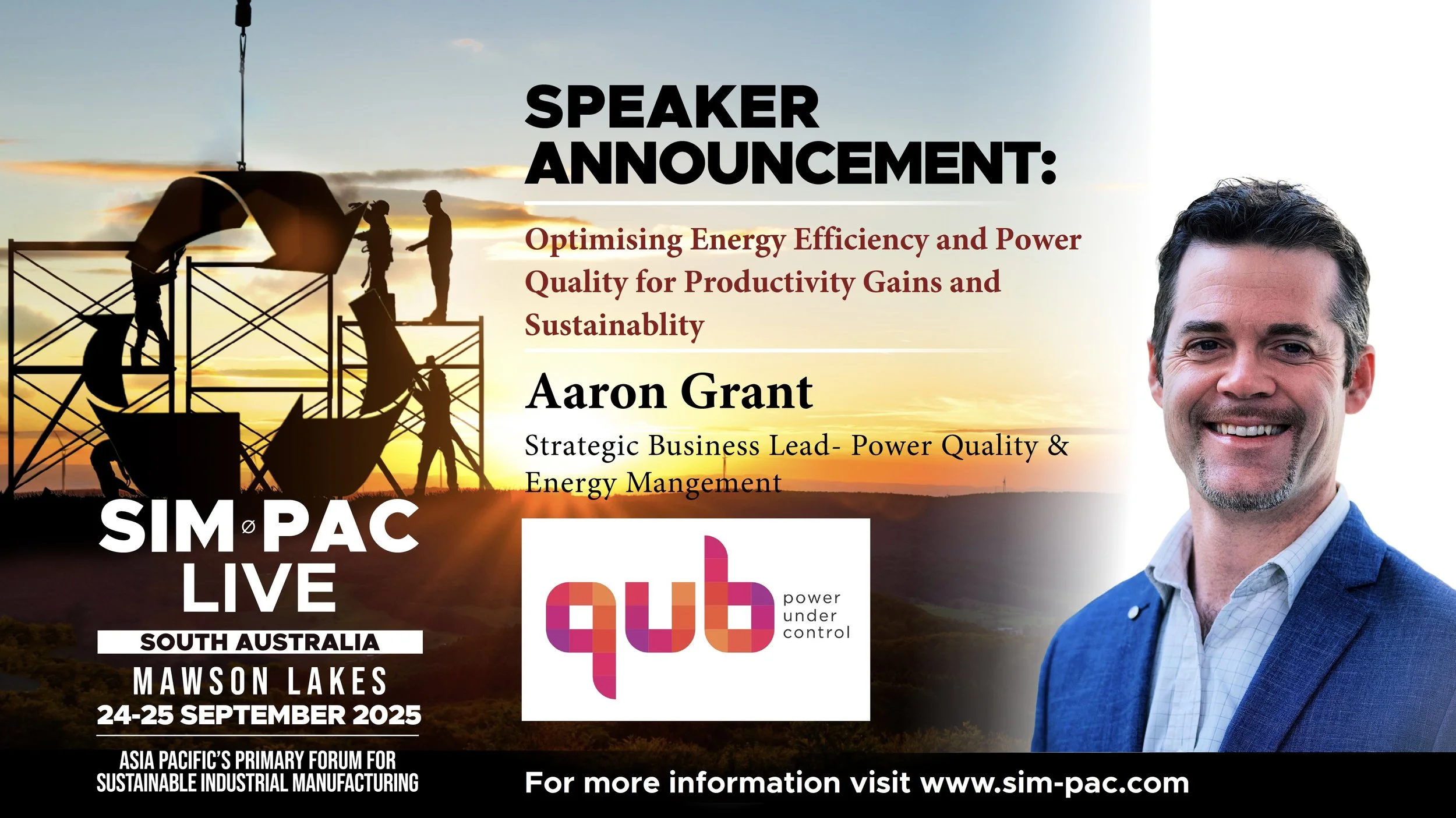
Click for more information about Aaron Grant
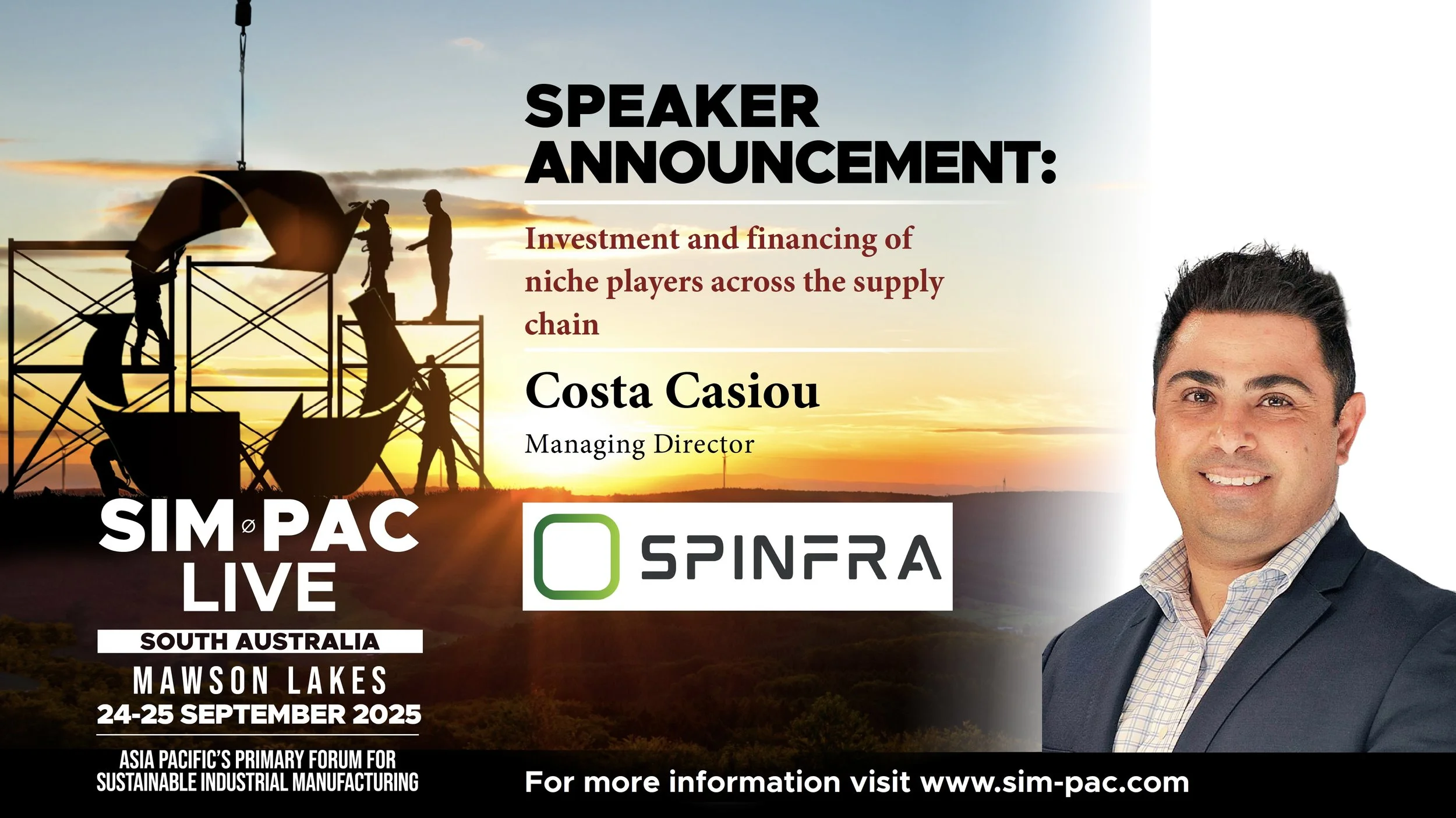
Click for more information about Costa Casiou

Click for more information about Daniel Perotti

Click for more information about Gary Andrews

Click for more information about Graham Davies
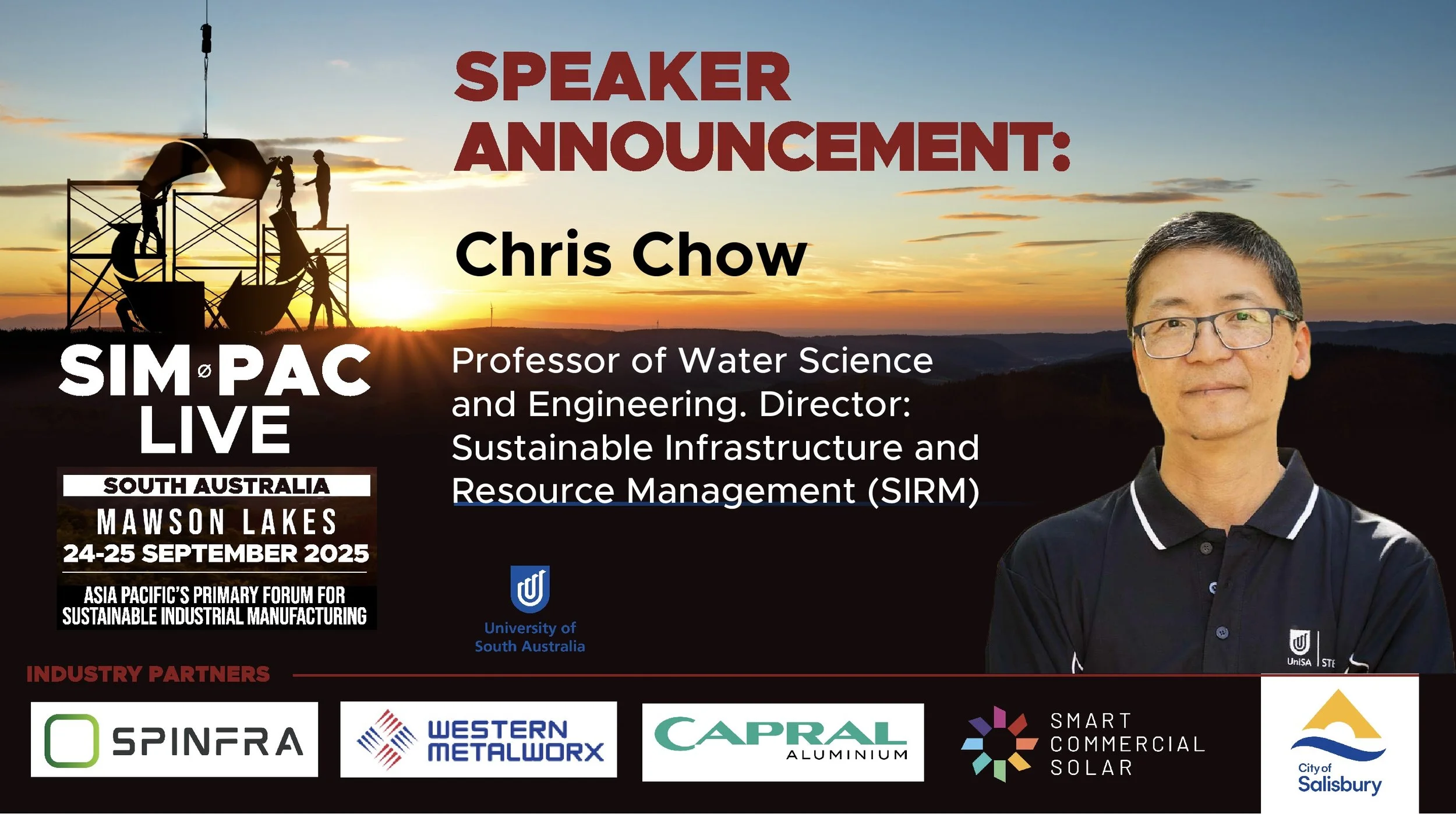
Click for more information about Chris Chow

Click for more information about Alan O'Connor

Click for more information about Dr. Jayant Keskar
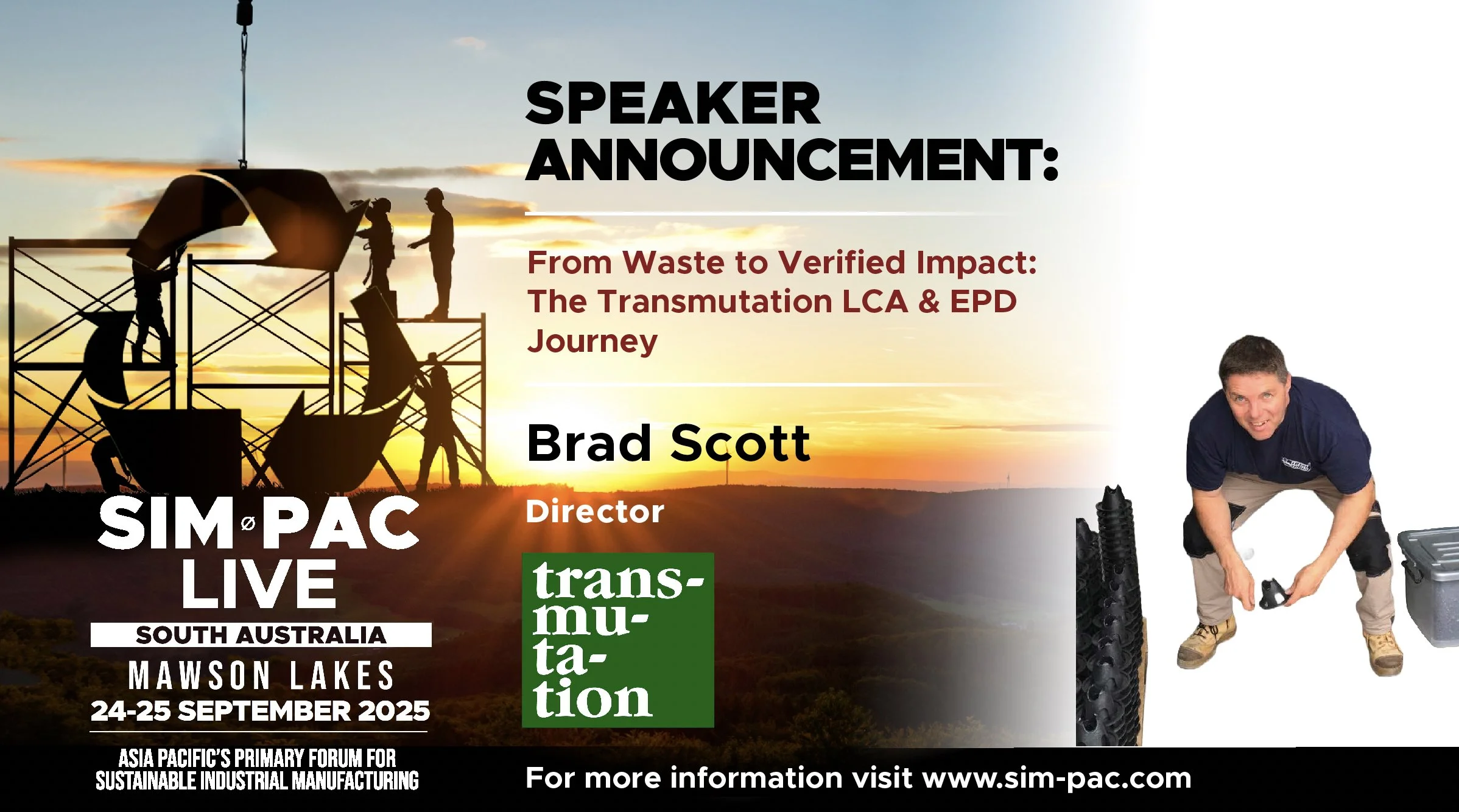
Click for more information about Brad Scott

Click for more information about Robby Franklin

Click for more information about Claire Kneller
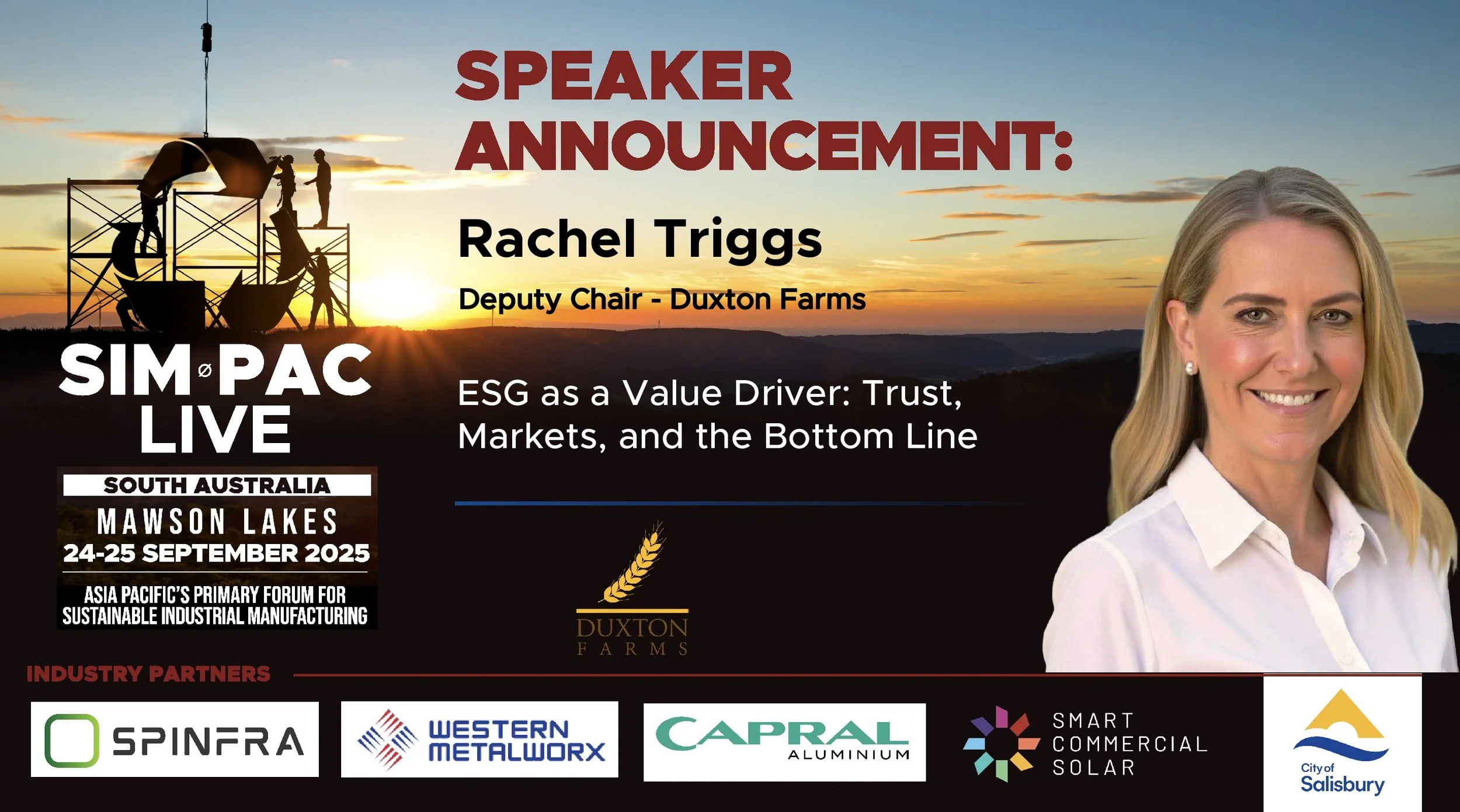
Click for more information about Rachel Triggs
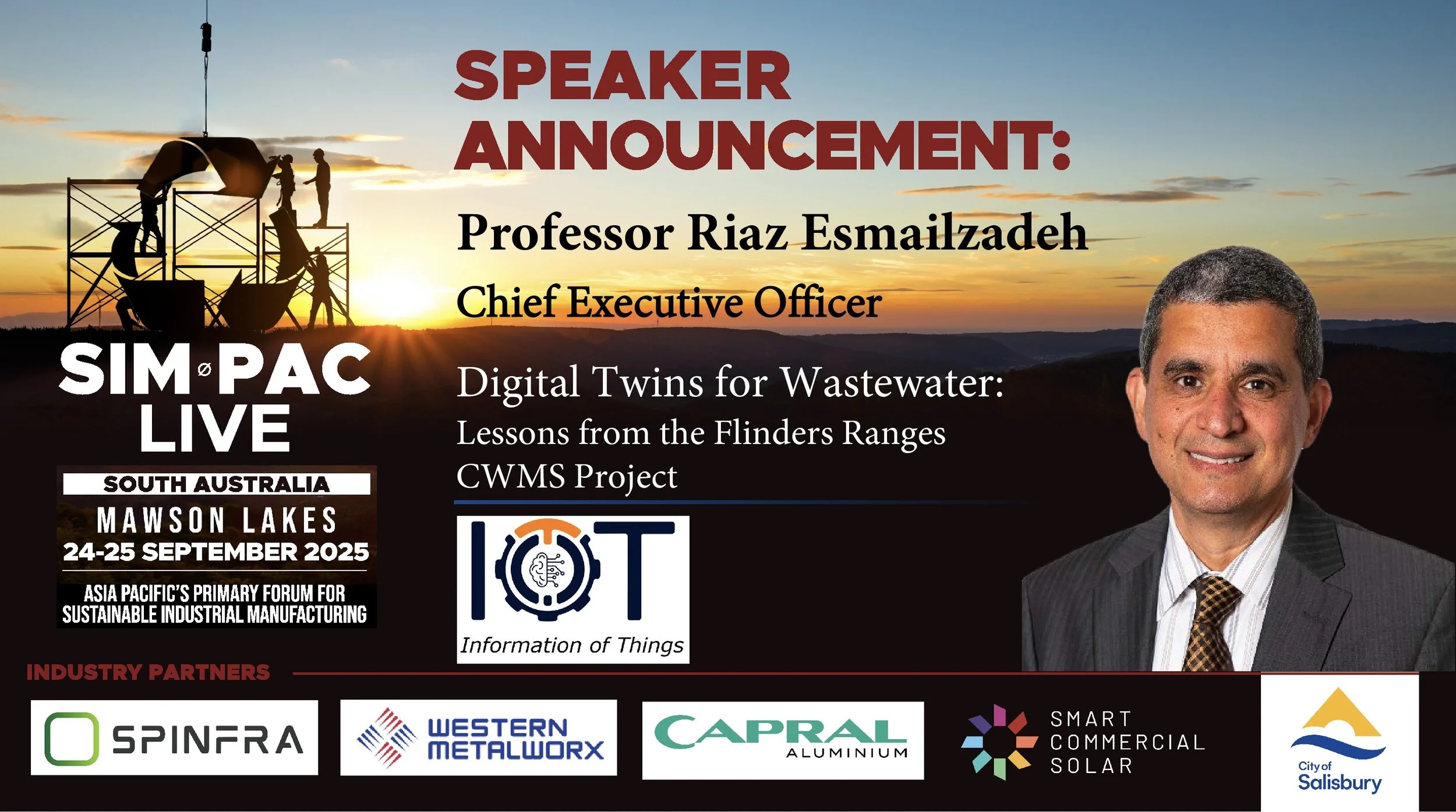
Click for more information about Riaz Esmailzadeh
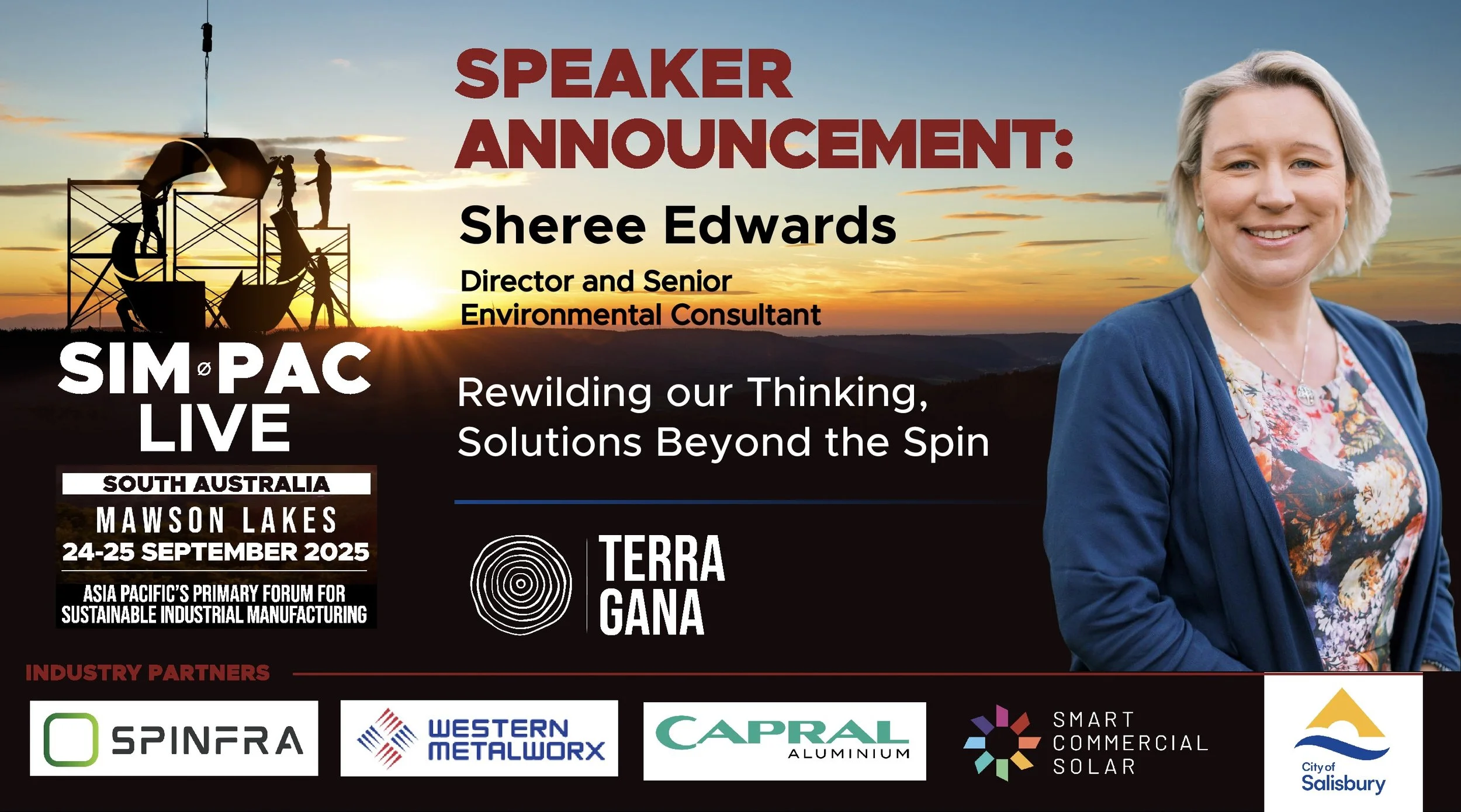
Click for more information about Sheree Edwards
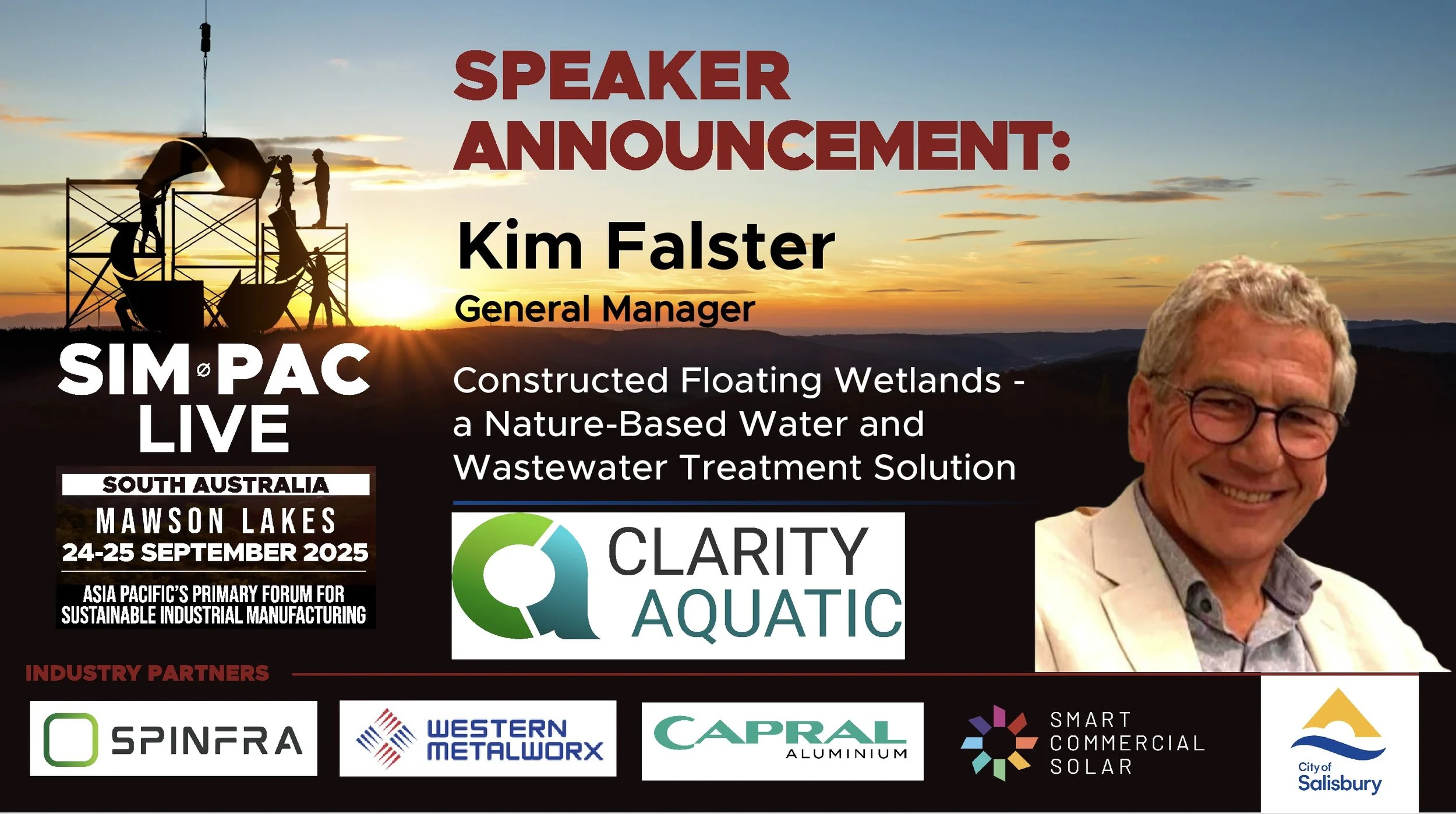
Click for more information about Kim Falster
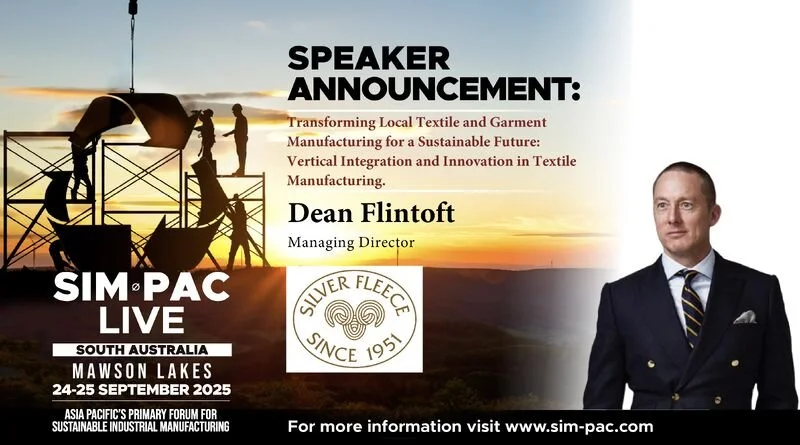
Click for more information about Dean Flintoft
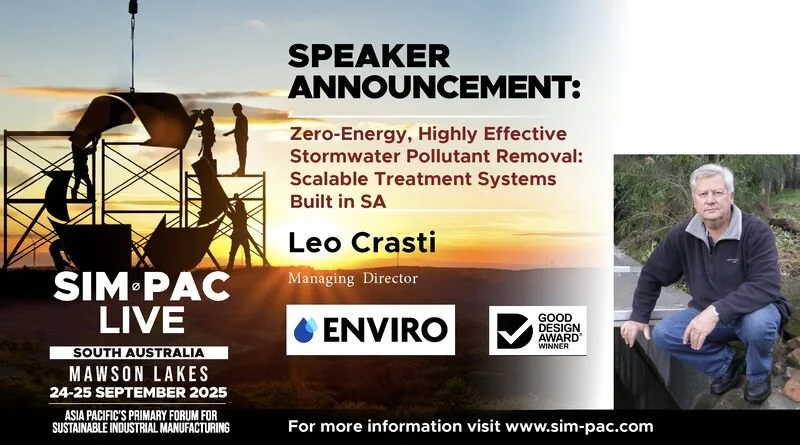
Click for more information about Leo Crasti
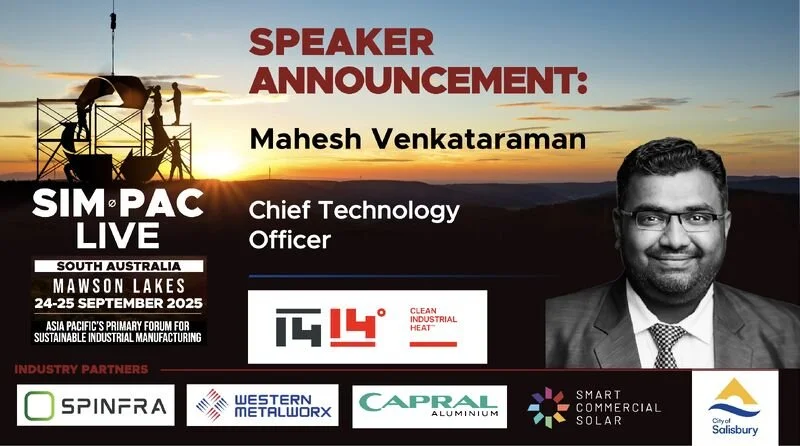
Click for more information about Mahesh Venkataraman
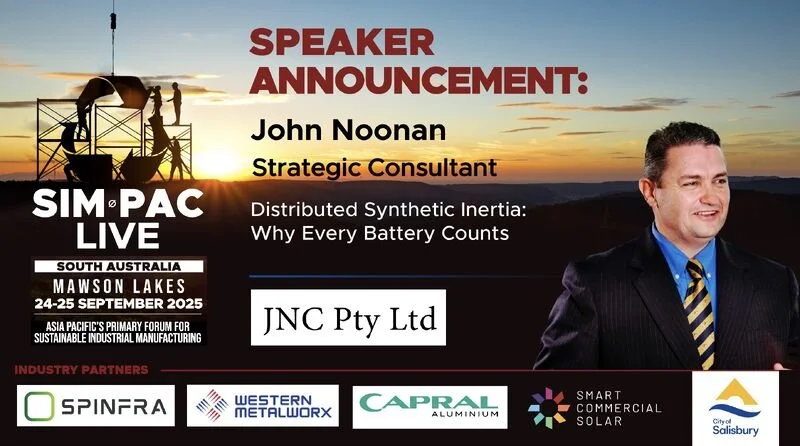
Click for more information about John Noonan
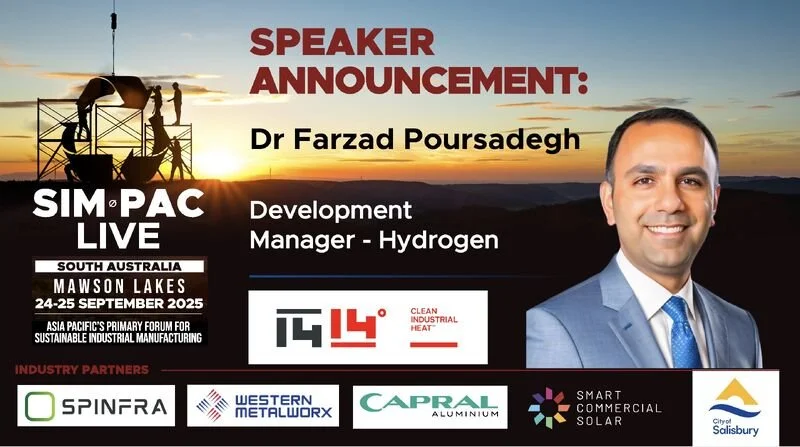
Click for more information about Dr. Farzad Poursadegh
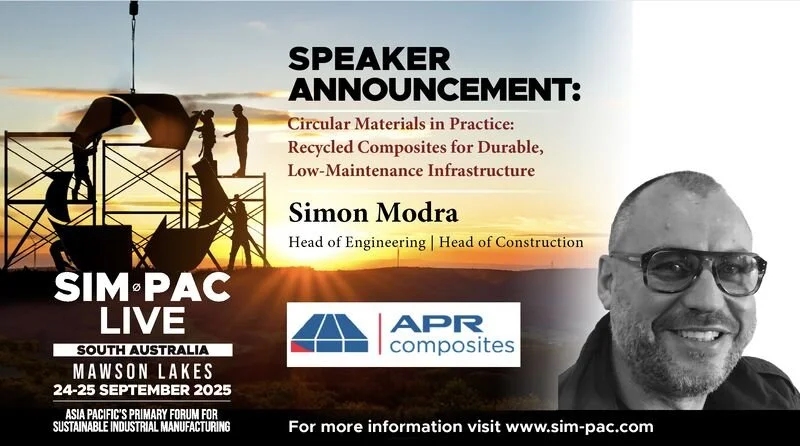
Click for more information about Simon Modra
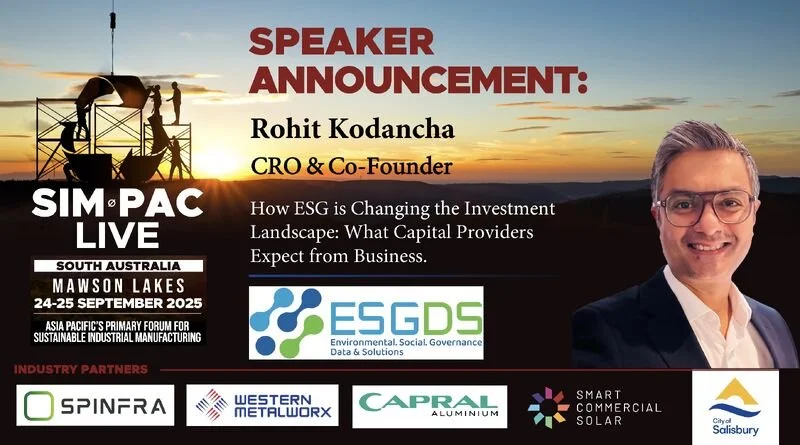
Click for more information about Rohit Kodancha

Click for more information about Huon Hoogesteger
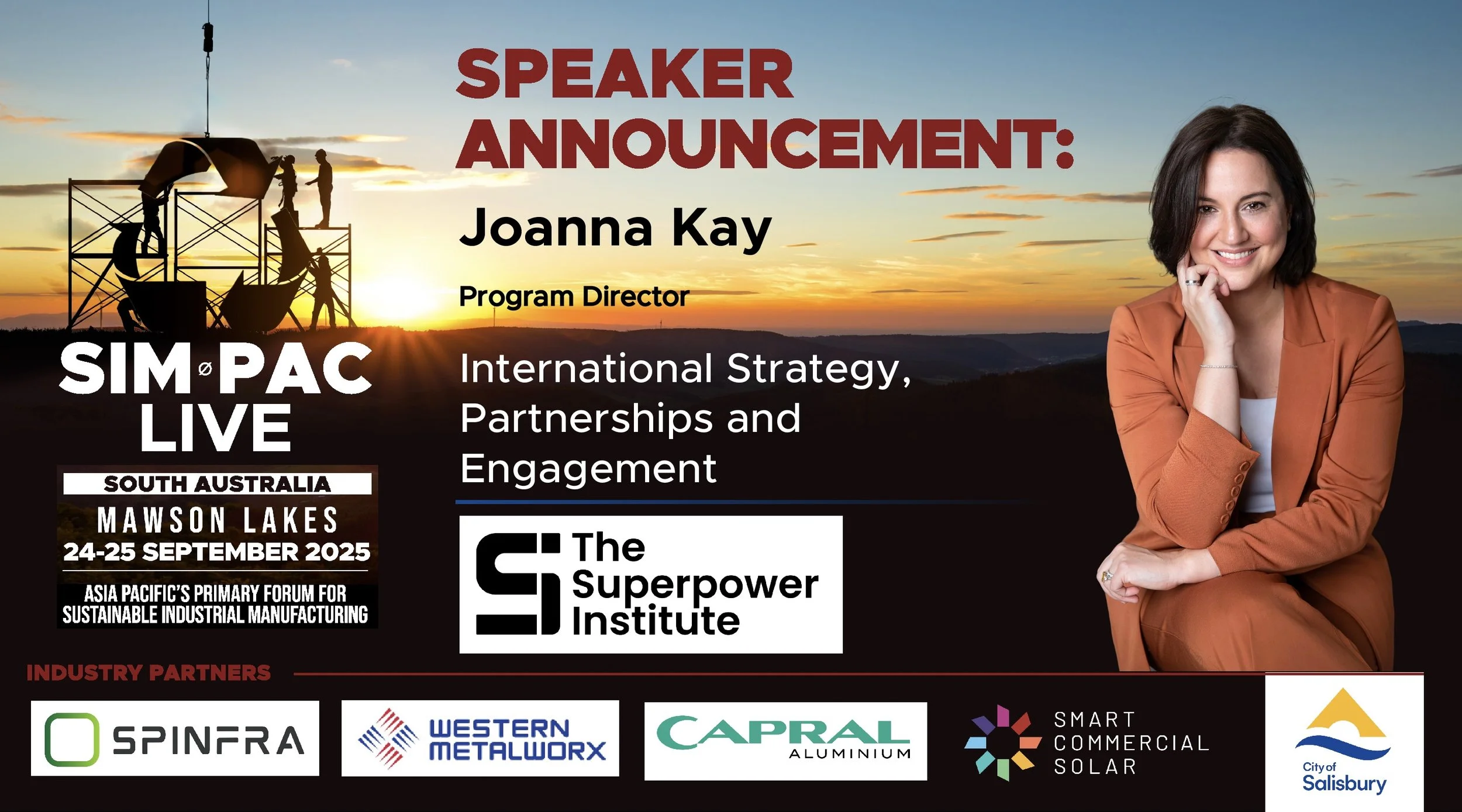
Click for more information about Joanna Kay
